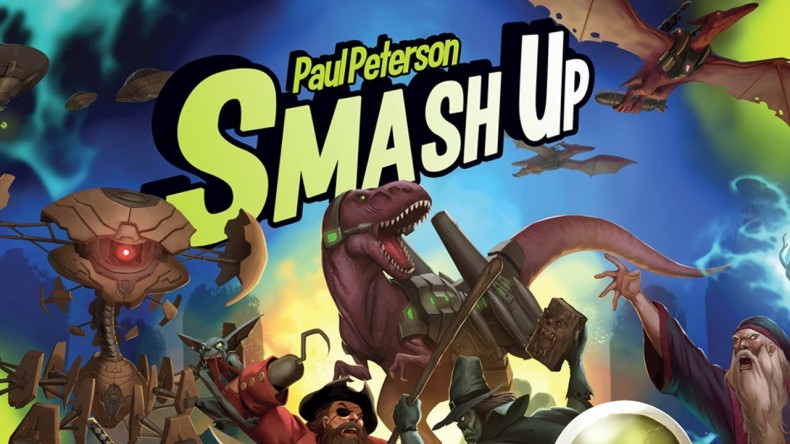“The shuffle-building game of total awesomeness!” Smash Up’s box cheerfully yells at you. It tells you everything you need to know about what Smash Up wants to be. It throws aliens, robots and weaponised dinosaurs into a big mixing pot and lets you play through the result – looking fast paced and full of action.
Your aim is to be the first to accrue 15 victory points, earned by contesting bases, several of which are in play at once. Each base card has a number in the top left which denotes its power, and you need the equivalent power from your minions – who also have a power rank in the top left – to win it. Doing so gives you the amount of victory points on the card, as well as giving a few to other players contesting the base, with the power checked at the end of each player’s turn.
You contest a base by playing minions and using actions – of which you can do one apiece per turn. Minions – ranked 1-7 in power – each have various abilities. Some can attack opposing minions, others allow for further cards to be played or buff the cards around them. It’s pretty generic card game stuff, but it’s easy to understand once in motion: you do as the cards tell you. Actions play on top of these and – again – are pretty self-explanatory, either helping you or hindering your opponent.
There’s eight factions to choose from, of which each player chooses two. Shuffling them together gets you your deck for the round. Each faction loosely has a theme, with a small part of your gameplan based around whom you pick. Ninjas for example can suddenly swamp you, while zombies can come back from your discard pile. It fits the stereotype each faction has in pop-culture, meaning even new players can get a grasp on who does what, even if it does still take several games with each faction to work out your favoured combination.

Everything adds up to make Smash Up easy to pick up but difficult to master. Deck style defines how you’ll play – I favour a robot/ninja setup, a slow build up of units that magnify each others power, then a rush of a few ninjas to quickly finish the job – but there’s no winning combination, impressive given how many factions there are.
Smash Up does have its fair share of problems though. The number of variables that alter turn by turn mean that a pen and paper is a must, and even then it’s nigh on impossible to keep track of certain numbers. One faction has a minion whose power magnifies during other player’s turns, but not your own, meaning you can win a base even when you haven’t played anything. It’s useful for a sneaky tactic but it’s too easy to forget about.
This need to keep working out the score has two knock-on effects as well. Firstly it just slows the pace right down – card games don’t have to be quick, but it is massively frustrating. More damning though, I found that player tend to focus on one base at a time; the demands of keeping track of several, as well as opponent’s scores, is overwhelming otherwise. As a result, this means that you can expend half your deck on claiming one base. It’s not an issue – when depleted you just shuffle your discard pile and start again – but it feels unnecessarily long and fussy.
And that’s Smash Up’s biggest issue. Clearly it is pitched at a younger audience – an early teens recommendation on the box – with talk of “total awesomeness”, but it requires a lot more thought than the buzzwords would suggest. Smash Up promises action, and it has thrown a lot of cool things into the pot to make that point, but in reality it’s a numbers game masquerading as something it’s not.





